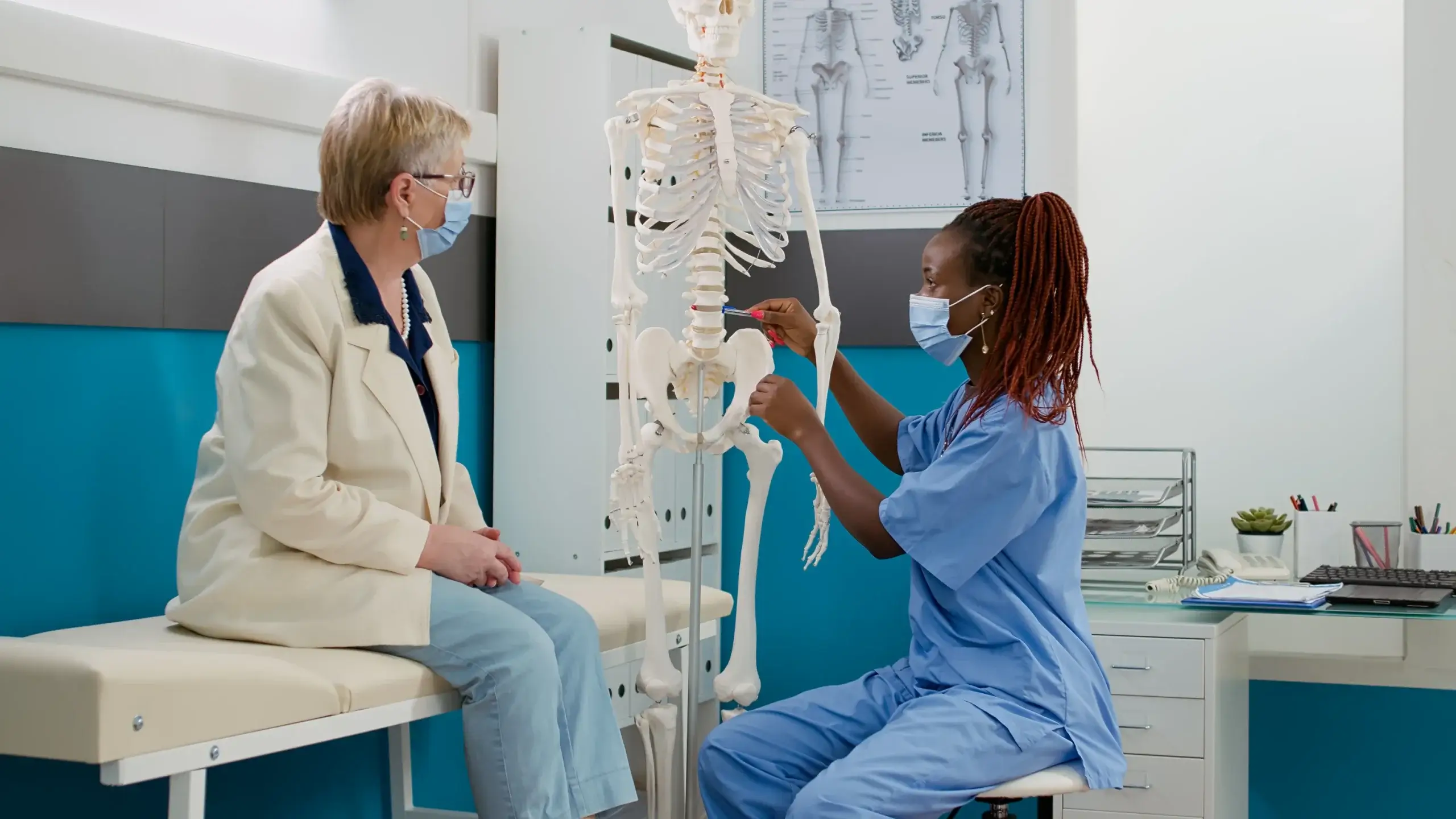
Understanding Osteoporosis Symptoms in Menopause: How to Protect Your Bones in Midlife
Osteoporosis Symptoms and Why They Matter During Menopause
Osteoporosis symptoms often develop silently, making it a “silent disease” that can catch many women off guard. During menopause, the natural decline in estrogen levels accelerates the process of bone loss, significantly raising the risk of developing osteoporosis. Osteoporosis, which literally means “porous bone,” is a progressive condition in which bones become weaker and more fragile, leading to an increased susceptibility to fractures. Typically, bone mass peaks around age 30 and gradually declines over time, but the hormonal changes associated with menopause cause this decline to speed up. In fact, within the first five to seven years after menopause, women can lose up to 20% of their bone density—a concerning statistic, as weakened bones are more prone to fractures, especially in areas like the hips, spine, and wrists. These fractures not only affect mobility but also compromise independence and overall quality of life. Unfortunately, osteoporosis doesn’t present noticeable symptoms until a fracture occurs, which is why many women don’t realize they have it until it’s too late.
The key is to stay vigilant and recognize early signs of bone loss, so that preventive measures can be taken before fractures happen. By understanding how osteoporosis symptoms are linked to menopause and its effects on bone health, women can take proactive steps to protect their bones. Early intervention through proper diet, exercise, and medical advice can significantly reduce the risk of fractures and ensure women maintain strong bones well into their later years, enabling them to enjoy a more active and independent lifestyle.
Osteoporosis Symptoms in Menopausal Women
Osteoporosis is often difficult to detect in its early stages, as it typically progresses without obvious signs—until a fracture occurs. However, there are subtle osteoporosis symptoms that menopausal women should be aware of, as these can serve as early indicators of declining bone health. Recognizing these signs early allows you to take preventive action before the condition worsens.
- Back Pain and Postural Changes
Chronic back pain is common, especially if it’s linked to vertebral fractures or spinal compression. If you experience persistent back pain, it may be a sign that the bones in your spine are weakening. Additionally, changes in posture—such as a curved back or noticeable loss of height—can be signs of osteoporosis. Over time, the spine may compress, leading to height loss, which can go unnoticed unless tracked. - Frequent or Unexpected Fractures
Another significant symptom is the occurrence of fractures from relatively minor accidents, such as a simple trip or bump. When bones become fragile, fractures can happen more easily, especially in the wrists, hips, and spine. These fractures should never be dismissed, as they are a strong indicator that the bones have lost significant density, signaling the presence of osteoporosis. - Brittle Nails and Weak Hair
Changes in nails and hair strength can also point to declining bone health. Brittle nails, thinning hair, or hair that breaks easily can indicate low calcium or vitamin D levels, which are crucial for maintaining strong bones. These outward signs may be an early indicator of osteoporosis. - Muscle Weakness and Joint Discomfort
Osteoporosis doesn’t just affect bones—it can also impact muscles and joints. As bones lose density, muscles may weaken, causing fatigue and discomfort. Joint stiffness may also increase, raising the risk of falls and injuries. These musculoskeletal symptoms can make it harder to stay active and can contribute to the likelihood of fractures. - Noticeable Loss of Height
A gradual loss of height may be linked to osteoporosis, particularly due to spinal compression fractures. If you notice that your height has decreased by more than an inch over time, it could be a sign of weakened vertebrae. Tracking height changes is a good way to spot potential problems, as this symptom often develops gradually and may go unnoticed.
By recognizing these symptoms early, menopausal women can take steps to protect their bone health. Early detection and action are crucial for preventing fractures and maintaining strength and independence. If you notice any of these signs, it’s important to consult with your healthcare provider to discuss further testing and treatment options.
Why Menopause Triggers Bone Loss
One of the key causes of bone loss during menopause is the significant drop in estrogen levels. Estrogen plays an essential role in bone remodeling, helping to maintain the balance between bone formation and resorption. As estrogen levels decrease, bone density declines, increasing the risk of fractures. For many women, this leads to osteoporosis symptoms such as brittle bones and fractures. However, menopause is not the only factor at play. Several other elements can contribute to osteoporosis:
- Age: Bone density naturally decreases over time, and this process speeds up after menopause.
- Genetics: A family history of osteoporosis or fractures can increase your likelihood of experiencing bone issues.
- Low Calcium & Vitamin D: These nutrients are vital for strong bones. A deficiency can make bones more fragile.
- Lifestyle Factors: Smoking, lack of exercise, and excessive alcohol consumption can all negatively affect bone strength.
- Medical Conditions: Thyroid issues, autoimmune diseases, and the long-term use of steroids can also elevate the risk of bone loss.
Understanding these risk factors can help you take preventative measures to safeguard your bone health before osteoporosis symptoms appear.
How Is Osteoporosis Diagnosed?
The most common way to diagnose osteoporosis is through a Bone Mineral Density (BMD) test, also called a DEXA scan. This scan measures bone density in key areas like the spine, hips, and wrists. It helps detect early signs of bone loss, making it crucial for women in menopause to monitor bone health. Along with the BMD scan, other tools may be used:
- Blood Tests: These can check levels of calcium, vitamin D, and thyroid hormones to ensure your body is supporting bone health.
- FRAX Score: This tool predicts your 10-year risk of fractures based on factors like age and medical history, which can help determine the likelihood of osteoporosis.
Early detection through these methods can help you manage osteoporosis symptoms and take action before they become a major concern.
How to Prevent Osteoporosis: Diet and Lifestyle Strategies
Even if you’re at risk, osteoporosis isn’t an inevitable outcome. By making proactive changes in diet and lifestyle, you can reduce your chances of developing it and maintain your bone health through menopause and beyond. Here are some practical strategies:
1. Eat a Bone-Boosting Diet
The foundation of bone health starts with what you eat. Focus on these key nutrients:
- Calcium: Found in dairy products, almonds, leafy greens, and fortified foods, calcium is crucial for maintaining bone strength.
- Vitamin D: Essential for calcium absorption, vitamin D can be obtained through sunlight, fatty fish (like salmon), and fortified milk.
- Magnesium: This mineral is important for bone structure, and it can be found in nuts, seeds, and whole grains.
- Protein: Adequate protein intake is essential for both bone and muscle health, helping to prevent muscle weakness and falls, which can lead to fractures.
2. Move for Stronger Bones
Physical activity is key to preserving bone density and preventing osteoporosis symptoms:
- Weight-Bearing Exercises: Activities like walking, dancing, and stair climbing put stress on your bones, stimulating them to stay strong and healthy.
- Strength Training: Lifting weights or using resistance bands helps build muscle mass, which is important for supporting your bones and preventing fractures.
- Balance Workouts: Practicing balance through yoga and Tai Chi can improve coordination and help prevent falls, which are a major risk for those with weak bones.
3. Lifestyle Changes That Matter
Certain lifestyle habits can either support or hinder bone health. Here’s what you can do:
- Quit Smoking: Smoking damages bone structure, reducing bone density over time and increasing the risk of osteoporosis symptoms.
- Limit Alcohol: Excessive alcohol consumption interferes with calcium absorption, weakening bones and increasing fracture risk.
- Maintain a Healthy Weight: Being underweight can lead to weaker bones, while being overweight can increase stress on your joints and bones.
- Fall-Proof Your Environment: Take steps to reduce the risk of falls by using non-slip mats, wearing proper footwear, and ensuring good lighting at home.
Medical Options for Managing Osteoporosis
Sometimes, lifestyle changes alone are not enough to prevent or manage osteoporosis symptoms. In these cases, medical options can help stabilize or even reverse bone loss. Your doctor may recommend:
1. Medications
- Bisphosphonates: These drugs help prevent further breakdown of bone and are often prescribed to treat osteoporosis.
- Selective Estrogen Receptor Modulators (SERMs): SERMs mimic estrogen’s protective effects on bones, reducing bone loss.
- Hormone Replacement Therapy (HRT): HRT may slow bone loss, especially in the early stages of menopause, by supplementing the estrogen that drops during this time.
- Denosumab: This biannual injection helps prevent bone resorption, slowing the progression of osteoporosis.
- Teriparatide: A bone-building medication used in severe cases to help stimulate new bone growth.
2. Supplements
To support bone health, calcium and vitamin D supplements are often recommended, especially for women going through menopause. However, it’s important to personalize the dosage based on individual needs—too much calcium can lead to kidney stones or cardiovascular issues.
With these dietary, lifestyle, and medical strategies, you can significantly reduce the risk of developing osteoporosis symptoms and keep your bones strong and resilient as you navigate menopause and beyond.
When to Talk to a Doctor
It’s crucial to consult a doctor if you notice any signs of osteoporosis symptoms. Early intervention can prevent complications and help you maintain an active lifestyle. Consider seeing a healthcare provider if you experience:
- Frequent or Unexplained Fractures: If you find yourself breaking bones more easily, especially from minor accidents or falls, this could be a sign of weakened bones due to osteoporosis symptoms.
- Noticeable Loss in Height or a Curved Back: A significant drop in height over time, or a noticeable change in posture such as a hunched or curved back, could indicate vertebral fractures associated with osteoporosis symptoms.
- Persistent Back or Joint Pain: Chronic pain in the back or joints, particularly if it’s accompanied by other signs like reduced flexibility or a curved spine, may point to bone-related issues like osteoporosis.
- Family History of Osteoporosis: If osteoporosis runs in your family, you may be at a higher risk. Talking to your doctor early can help monitor your bone health.
- Postmenopausal and Haven’t Had a Recent Bone Scan: If you are postmenopausal and haven’t had a recent bone density scan, it’s important to schedule one. Monitoring your bone density regularly can help identify any bone loss early, especially when you’re at a higher risk of osteoporosis symptoms due to hormonal changes during menopause.
Getting a diagnosis and starting treatment early can make a big difference in preventing complications and maintaining bone health. Don’t wait until the problem becomes more advanced—take charge of your health today.
Conclusion
While osteoporosis symptoms may be silent, the consequences of untreated bone loss are anything but. Early detection and intervention, particularly during menopause when the risk of osteoporosis increases, can make a world of difference. By adopting a proactive approach to bone health through proper nutrition, regular physical activity, and timely medical care, you can significantly reduce the impact of osteoporosis on your life.
Remember, midlife isn’t the end of strength—it’s the beginning of a new, empowered chapter. Prioritize your bone health now to ensure you stay strong, mobile, and independent for years to come. Protect your bones today and give yourself the foundation for a healthier tomorrow.
FAQs
While osteoporosis cannot be fully reversed, it is possible to slow or even stop further bone loss with the right treatment. A combination of medications, such as bisphosphonates or hormone replacement therapy (HRT), along with lifestyle changes like weight-bearing exercises and a bone-healthy diet, can significantly improve bone density and prevent fractures.
Women should start getting regular bone density tests around the age of 65, or earlier if they have risk factors like a family history of osteoporosis, smoking, excessive alcohol consumption, or early menopause. Monitoring earlier can help detect bone loss before significant fractures occur.
Back pain can be a common symptom of osteoporosis, particularly if it’s caused by a vertebral fracture. If you experience persistent, unexplained back pain or notice a curved posture (like a hunched back), it’s worth consulting your doctor for a bone density test. Early diagnosis can help manage osteoporosis before it worsens.
Yes, osteoporosis can be prevented or its progression slowed with a proactive approach. Focus on a diet rich in calcium and vitamin D, engage in weight-bearing exercises like walking or strength training, avoid smoking, and limit alcohol intake. Regular bone density tests are also essential to catch early signs of osteoporosis.
Osteoporosis medications, including bisphosphonates, SERMs, and HRT, are generally safe for postmenopausal women, but it’s important to discuss potential risks with your doctor. Every woman’s needs are different, and medications can be tailored to suit individual health profiles. Regular check-ups will ensure that any side effects are managed effectively.

Sonakshi Kandhari





